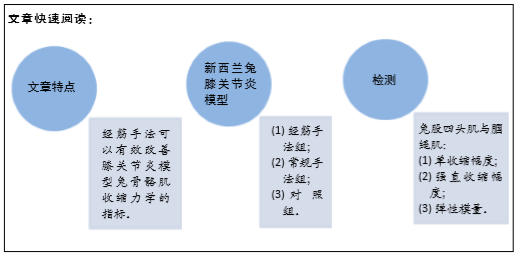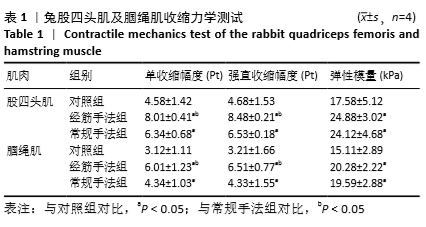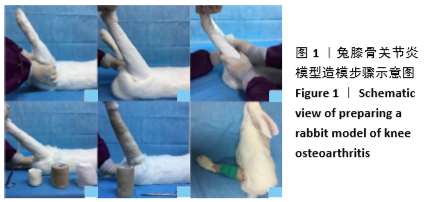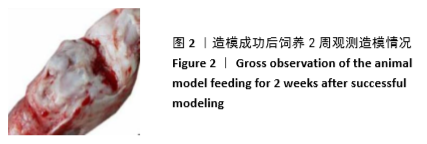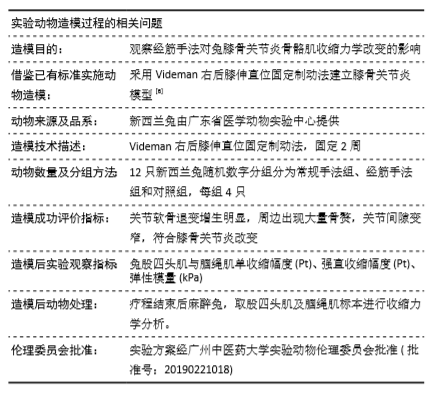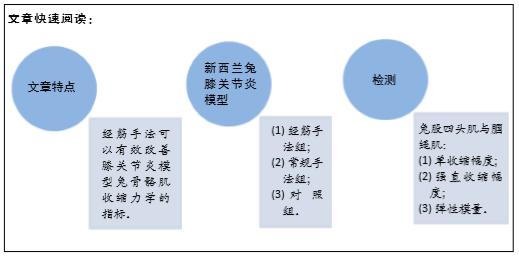[1] MOBASHERI A, BAY-JENSEN AC, VAN SPIL WE, et al. Osteoarthritis Year in Review 2016: biomarkers (biochemical markers). Osteoarthritis Cartilage. 2017;25(2): 199-208.
[2] Zult T, Gokeler A, van Raay JJ AM, et al. An anterior cruciate ligament injury does not affect the neuromuscular function of the non-injured leg except for dynamic balance and voluntary quadriceps activation. Knee Surg Sports Traumatol Arthrosc. 2017;25(1):172-183.
[3] 黄旭东,韩清民,陈小勇.95例膝骨关节炎六经筋辨证分布规律的临床研究[J].辽宁中医杂志,2010 37(11):2187.
[4] 黄旭东,韩清民.经筋辨证外治法治疗足太阳经筋型膝骨关节炎的临床对照研究[J].吉林中医药,2016,36(10):1024-1026.
[5] 黄旭东,韩清民.膝骨关节炎足太阳经筋证腘绳肌柔韧性的临床对照研究[J].广州中医药大学学报,2016,33(4):502-505.
[6] 曾俊华,马笃军,彭力平,等.实验兔膝骨关节炎模型的建立及鉴定[J].中国临床研究,2016,29(5):679-682.
[7] Shimoura K, Iijima H, Suzuki Y, et al.Immediate effects of transcutaneous electrical nerve stimulation on pain and physical performance in individuals with pre-radiographic knee steoarthritis: a randomized controlled trial.Arch Phys Med Rehabil.2018;9(7):713-724.
[8] ØIESTAD BE, JUHL CB, EITZEN I, et al. Knee extensor muscle weakness is a risk factor for development of knee osteoarthritis. A systematic review and meta-analysis. Osteoarthritis Cartilage.2015;23(2):171-177.
[9] CULVENOR AG, RUHDORFER A, JUHL C, et al. Knee Extensor Strength and Risk of Structural, Symptomatic, and Functional Decline in Knee Osteoarthritis: A Systematic Review and Meta-Analysis.Arthr Care Res.2017;69(5):649-658.
[10] VANNINI F, SPALDING T, ANDRIOLO L, et al. Sport and early osteoarthritis: the role of sport in aetiology, progression and treatment of knee osteoarthritis.Knee Surg Sports Traumatol Arthrosc.2016;24(6):1786-1796.
[11] ENGEBRETSEN A H, MYKLEBUST G, HOLME I, et al.Intrinsic risk factors for acute knee injuries among male football players: a prospective cohort study. Scand J Med Sci Sports. 2011;21(5): 645-652.
[12] Wada O, Kurita N, Kamitani T, et al.Influence of the severity of knee osteoarthritis on the association between leg muscle mass and quadriceps strength: the SPSS-OK study.Clin Rheumatol. 2012;12(11):123-135.
[13] Norte GE, Hertel JN, Saliba S, et al.Quadriceps Function and Patient-Reported Outcomes After Anterior Cruciate Ligament Reconstruction in Patients With or Without Knee Osteoarthritis. J Athl Train. 2013;31(4): 511-526.
[14] 安丙辰,郑洁皎,沈利岩.膝骨关节炎与膝关节伸、屈肌群肌力的相关性研究[J].医用生物力学, 2015, 30(2): 174-178.
[15] DeVita P, Aaboe J, Bartholdy C, et al.Quadriceps-strengthening exercise and quadriceps and knee biomechanics during walking in knee osteoarthritis: A two-centre randomized controlled trial. Clin Biomech (Bristol, Avon).2015;51(1): 40-48.
[16] 张伟强,李波,李帆冰.膝骨性关节炎分期与疼痛部位的相关性研究[J].云南中医学院学报,2016, 39(5):78-81.
|
